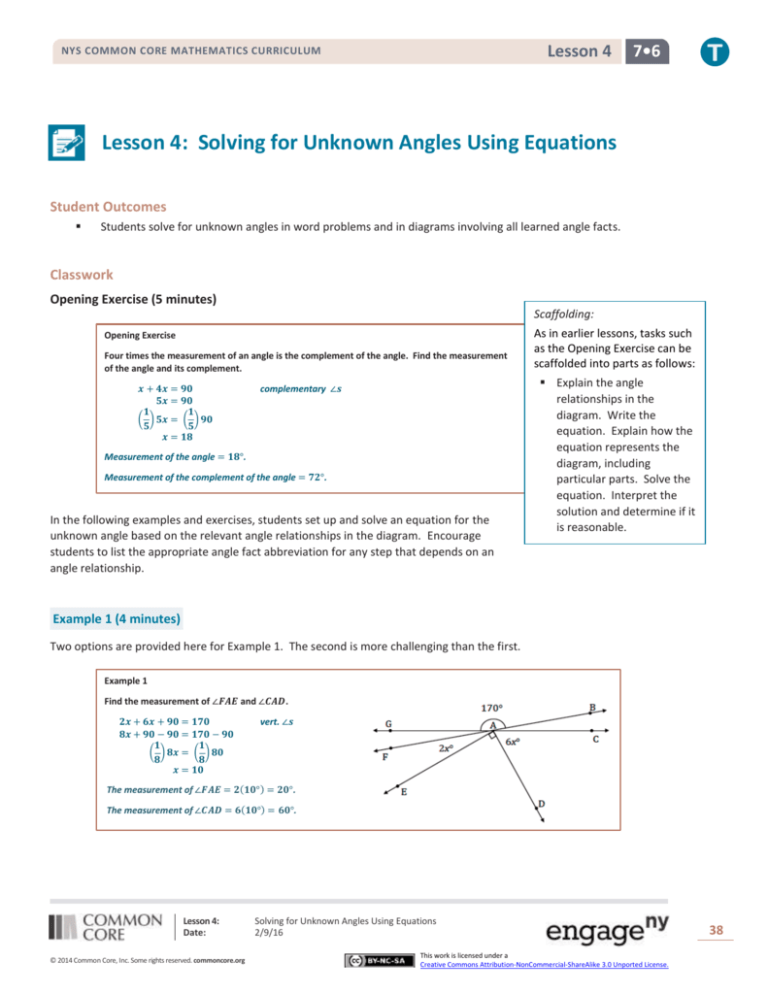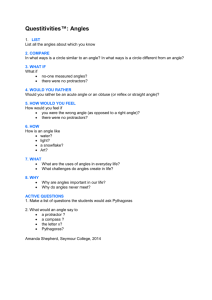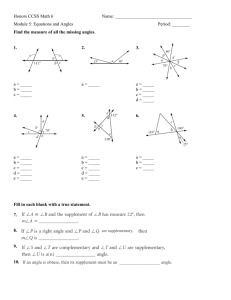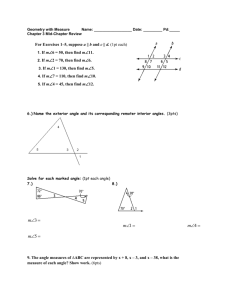
Lesson 4
NYS COMMON CORE MATHEMATICS CURRICULUM
7•6
Lesson 4: Solving for Unknown Angles Using Equations
Student Outcomes
Students solve for unknown angles in word problems and in diagrams involving all learned angle facts.
Classwork
Opening Exercise (5 minutes)
Scaffolding:
Opening Exercise
Four times the measurement of an angle is the complement of the angle. Find the measurement
of the angle and its complement.
𝒙 + 𝟒𝒙 = 𝟗𝟎
𝟓𝒙 = 𝟗𝟎
𝟏
𝟏
( ) 𝟓𝒙 = ( ) 𝟗𝟎
𝟓
𝟓
𝒙 = 𝟏𝟖
complementary ∠𝒔
Measurement of the angle = 𝟏𝟖°.
Measurement of the complement of the angle = 𝟕𝟐°.
In the following examples and exercises, students set up and solve an equation for the
unknown angle based on the relevant angle relationships in the diagram. Encourage
students to list the appropriate angle fact abbreviation for any step that depends on an
angle relationship.
As in earlier lessons, tasks such
as the Opening Exercise can be
scaffolded into parts as follows:
Explain the angle
relationships in the
diagram. Write the
equation. Explain how the
equation represents the
diagram, including
particular parts. Solve the
equation. Interpret the
solution and determine if it
is reasonable.
Example 1 (4 minutes)
Two options are provided here for Example 1. The second is more challenging than the first.
Example 1
Find the measurement of ∠𝑭𝑨𝑬 and ∠𝑪𝑨𝑫.
𝟐𝒙 + 𝟔𝒙 + 𝟗𝟎 = 𝟏𝟕𝟎
𝟖𝒙 + 𝟗𝟎 − 𝟗𝟎 = 𝟏𝟕𝟎 − 𝟗𝟎
𝟏
𝟏
( ) 𝟖𝒙 = ( ) 𝟖𝟎
𝟖
𝟖
𝒙 = 𝟏𝟎
vert. ∠𝒔
The measurement of ∠𝑭𝑨𝑬 = 𝟐(𝟏𝟎°) = 𝟐𝟎°.
The measurement of ∠𝑪𝑨𝑫 = 𝟔(𝟏𝟎°) = 𝟔𝟎°.
Lesson 4:
Date:
© 2014 Common Core, Inc. Some rights reserved. commoncore.org
Solving for Unknown Angles Using Equations
2/9/16
This work is licensed under a
Creative Commons Attribution-NonCommercial-ShareAlike 3.0 Unported License.
38
7•6
Lesson 4
NYS COMMON CORE MATHEMATICS CURRICULUM
Two lines meet at a point. List the relevant angle relationship in the diagram. Set up
and solve an equation to find the value of 𝒙. Find the measurement of one of the
vertical angles.
(x+64)°
3x°
Students use information in the figure and a protractor to solve for 𝑥.
i)
Students will measure a 64° angle as shown; the remaining portion of the angle must be 𝑥° (∠𝑠 add).
ii)
Students can use their protractor to find the measurement of 𝑥 and use this measurement to partition the
other angle in the vertical pair.
x°
As a check, students should substitute the measured 𝑥 value into each expression and
evaluate; each angle of the vertical pair should be equal to the other. Students can also
MP.7 use their protractor to measure each angle of the vertical angle pair.
x°
x°
With a modified figure, students can write an algebraic equation that they have the skills
to solve:
𝟐𝒙 = 𝟔𝟒
𝟏
𝟏
( ) 𝟐𝒙 = ( ) 𝟔𝟒
𝟐
𝟐
𝒙 = 𝟑𝟐
64°
x°
vert. ∠𝒔
Measurement of each angle in the vertical pair: 𝟑(𝟑𝟐°) = 𝟗𝟔°
Extension:
𝟑𝒙 = 𝒙 + 𝟔𝟒
𝟑𝒙 − 𝒙 = 𝒙 − 𝒙 + 𝟔𝟒
𝟐𝒙 = 𝟔𝟒
𝟏
𝟏
( ) 𝟐𝒙 = ( ) 𝟔𝟒
𝟐
𝟐
𝒙 = 𝟑𝟐
vert. ∠𝒔
Measurement of each angle in the vertical pair: 𝟑(𝟑𝟐°) = 𝟗𝟔°
Exercise 1 (4 minutes)
Exercise 1
Set up and solve an equation to find the value of 𝒙. List the relevant angle relationship in the diagram. Find the
measurement of one of the vertical angles.
5x°
(x+132)°
Lesson 4:
Date:
© 2014 Common Core, Inc. Some rights reserved. commoncore.org
Solving for Unknown Angles Using Equations
2/9/16
This work is licensed under a
Creative Commons Attribution-NonCommercial-ShareAlike 3.0 Unported License.
39
Lesson 4
NYS COMMON CORE MATHEMATICS CURRICULUM
7•6
Students use information in the figure and a protractor to solve for 𝑥.
Measure a 66° angle as shown; the remaining portion of the
original angle must be 𝑥 (∠𝑠 add).
i)
ii)
x°
x°
x°
Partition the other angle in the vertical pair into equal angles of
𝑥°.
x°
x°
x°
Students should perform a check (as in Example 1) before solving an equation
that matches the modified figure.
132°
Extension:
𝟒𝒙 = 𝟏𝟑𝟐
𝟏
𝟏
( ) 𝟒𝒙 = ( ) 𝟏𝟑𝟐
𝟒
𝟒
𝒙 = 𝟑𝟑
vert. ∠𝒔
Measurement of each vertical angle: 𝟓(𝟑𝟑) = 𝟏𝟔𝟓°
Note: Students can check their answers for any question by measuring each unknown angle with a protractor, as all
diagrams are drawn to scale.
Example 2 (4 minutes)
Example 2
Three lines meet at a point. List the relevant angle relationships in the diagram. Set up and solve an equation to find the
value of 𝒃.
Let 𝒃 = 𝒄.
𝒄 + 𝟑𝟕 + 𝟒𝟑 = 𝟏𝟖𝟎
𝒄 + 𝟖𝟎 = 𝟑𝟔𝟎
𝒄 + 𝟖𝟎 − 𝟖𝟎 = 𝟑𝟔𝟎 − 𝟖𝟎
𝒄 = 𝟏𝟎𝟎
b°
∠𝒔 on a line
37°
𝒄˚
43°
Since 𝒃 = 𝒄, 𝒄 = 𝟏𝟎𝟎
Exercise 2 (4 minutes)
Students set up and solve an equation for the unknown angle based on the relevant angle relationships in the diagram.
List the appropriate angle fact abbreviation in the initial equation.
Exercise 2
Two lines meet at the common vertex of two rays. List the relevant angle
relationships in the diagram. Set up and solve an equation to find the value of 𝒃.
𝒃 + 𝟗𝟓 = 𝟗𝟎 + 𝟖𝟎
𝒃 + 𝟗𝟓 − 𝟗𝟓 = 𝟏𝟕𝟎 − 𝟗𝟓
𝒃 = 𝟕𝟓
Lesson 4:
Date:
© 2014 Common Core, Inc. Some rights reserved. commoncore.org
95°
vert. ∠𝒔
b°
80°
Solving for Unknown Angles Using Equations
2/9/16
This work is licensed under a
Creative Commons Attribution-NonCommercial-ShareAlike 3.0 Unported License.
40
Lesson 4
NYS COMMON CORE MATHEMATICS CURRICULUM
7•6
Example 3 (6 minutes)
Students set up and solve an equation for the unknown angle based on the relevant angle relationship in the question.
In this case, suggest that students use the words “angle” and “supplement” as placeholders in their equations. Students
can use a tape diagram to solve for the unknown angles.
Example 3
𝟐
The measurement of an angle is the measurement of its supplement. Find the measurement of the angle.
𝟑
𝟐
𝒂𝒏𝒔𝒘𝒆𝒓 = (𝟏𝟖𝟎 − 𝒂𝒏𝒈𝒍𝒆)
𝟑
Using a tape diagram:
𝟓 units = 𝟏𝟖𝟎
𝟐 units
𝟏 unit = 𝟑𝟔
𝟏𝟖𝟎
𝟐 units = 𝟕𝟐
𝟑 units
𝟑 units = 𝟏𝟎𝟖
The measurements of the two supplementary angles that satisfy these criteria are 𝟕𝟐° and 𝟏𝟎𝟖°.
The tape diagram model is an ideal strategy for this question. If students are not familiar with the tape diagram model,
use a ‘guess and check’ table with them. Here is an example of such a table with two entries for guesses that did not
result in a correct answer.
2
(Guess)
3
2
(60) = 40
3
2
(90) = 60
3
Guess
60
90
Sum (should be 180°)
60 + 40 = 100; not the answer
90 + 60 = 150; not the answer
Exercise 3 (5 minutes)
Students set up and solve an equation for the unknown angle based on the relevant angle relationship in the question.
In this case, suggest that students use the words “angle” and “complement” as placeholders in their equations. Students
can use a tape diagram to solve for the unknown angles.
Exercise 3
The measurement of an angle is
𝟏
𝟒
the measurement of its complement. Find the measurement of the angle.
𝟏
(𝟗𝟎 − 𝒂𝒏𝒈𝒍𝒆)
𝟒
Using a tape diagram:
𝒂𝒏𝒔𝒘𝒆𝒓 =
𝟓 units = 𝟗𝟎
𝟏 unit
𝟏 unit = 𝟏𝟖
𝟗𝟎
𝟒 units
𝟒 units = 𝟕𝟐
The measurements of the two complementary
angles that satisfy these criteria are 𝟏𝟖° and 𝟕𝟐°.
Lesson 4:
Date:
© 2014 Common Core, Inc. Some rights reserved. commoncore.org
Solving for Unknown Angles Using Equations
2/9/16
This work is licensed under a
Creative Commons Attribution-NonCommercial-ShareAlike 3.0 Unported License.
41
Lesson 4
NYS COMMON CORE MATHEMATICS CURRICULUM
7•6
Example 4 (4 minutes)
Example 4
Three lines meet at the common vertex of a ray. List the relevant angle relationships in the diagram. Set up and solve an
equation to find the value of 𝒛.
Let 𝒙° be the measurement of the indicated angle.
𝒙 + 𝟗𝟎 + 𝟐𝟗 = 𝟏𝟖𝟎
𝒙 + 𝟏𝟏𝟗 = 𝟏𝟖𝟎
𝒙 + 𝟏𝟏𝟗 − 𝟏𝟏𝟗 = 𝟏𝟖𝟎 − 𝟏𝟏𝟗
𝒙 = 𝟔𝟏
∠𝒔 on a line
𝒙°
29°
z°
𝒛 = 𝒙 + 𝟗𝟎
𝒛 = 𝟔𝟏 + 𝟗𝟎
𝒛 = 𝟏𝟓𝟏
∠𝒔 add
Exercise 4 (4 minutes)
Exercise 4
Two lines meet at the common vertex of two rays. Set up and solve an equation to find the value of 𝒙. Find the
measurement of ∠𝑮𝑨𝑭 and of ∠𝑩𝑨𝑪.
Let 𝒚° be the measurement of the indicated angle.
𝒚 = 𝟏𝟖𝟎 − (𝟗𝟎 + 𝟑𝟔)
𝒚 = 𝟓𝟒
∠𝒔 on a line
𝟒𝒙 + 𝒚 + 𝟓𝒙 = 𝟏𝟖𝟎
𝟒𝒙 + 𝟓𝟒 + 𝟓𝒙 = 𝟏𝟖𝟎
𝟗𝒙 + 𝟓𝟒 = 𝟏𝟖𝟎
𝟗𝒙 + 𝟓𝟒 − 𝟓𝟒 = 𝟏𝟖𝟎 − 𝟓𝟒
𝟗𝒙 = 𝟏𝟐𝟔
𝟏
𝟏
( ) 𝟗𝒙 = ( ) 𝟏𝟐𝟔
𝟗
𝟗
𝒙 = 𝟏𝟒
∠𝒔 on a line
F
G
E
4x°
𝒚°
C
36°
5x°
A
D
B
The measurement of ∠𝑮𝑨𝑭: 𝟒(𝟏𝟒˚) = 𝟓𝟔°.
The measurement of ∠𝑩𝑨𝑪: 𝟓(𝟏𝟒˚) = 𝟕𝟎°.
Closing (1 minute)
In every unknown angle problem, it is important to identify the angle relationship(s) correctly in order to set
up an equation that will yield the unknown value.
Check your answer by substituting and/or measuring to be sure it is correct.
Exit Ticket (4 minutes)
Lesson 4:
Date:
© 2014 Common Core, Inc. Some rights reserved. commoncore.org
Solving for Unknown Angles Using Equations
2/9/16
This work is licensed under a
Creative Commons Attribution-NonCommercial-ShareAlike 3.0 Unported License.
42
7•6
Lesson 4
NYS COMMON CORE MATHEMATICS CURRICULUM
Name
Date
Lesson 4: Solving for Unknown Angles Using Equations
Exit Ticket
𝐵𝐶 and 𝐸𝐹 meet at 𝐴. 𝐴𝐺 and 𝐴𝐷 form a right angle. Set up and solve an equation to find the values of 𝑥 and 𝑤.
E
G
50°
B
A
x°
D
60°
w°
C
F
Lesson 4:
Date:
© 2014 Common Core, Inc. Some rights reserved. commoncore.org
Solving for Unknown Angles Using Equations
2/9/16
This work is licensed under a
Creative Commons Attribution-NonCommercial-ShareAlike 3.0 Unported License.
43
Lesson 4
NYS COMMON CORE MATHEMATICS CURRICULUM
7•6
Exit Ticket Sample Solutions
Lines 𝑩𝑪 and 𝑬𝑭 meet at 𝑨. Rays 𝑨𝑮 and 𝑨𝑫 form a right angle. Set up and solve an equation to find the values of 𝒙 and
𝒘.
∠𝑩𝑨𝑬 = 𝟔𝟎
∠𝑩𝑨𝑮 = 𝟏𝟎
E
vert. ∠𝒔
∠𝒔 add
𝒙 + ∠𝑩𝑨𝑮 = 𝟗𝟎
𝒙 + 𝟏𝟎 = 𝟗𝟎
𝒙 + 𝟏𝟎 − 𝟏𝟎 = 𝟗𝟎 − 𝟏𝟎
𝒙 = 𝟖𝟎
G
50°
B
complementary ∠𝒔
A
x°
𝒙 + 𝒘 + 𝟔𝟎 = 𝟏𝟖𝟎
𝟖𝟎 + 𝒘 + 𝟔𝟎 = 𝟏𝟖𝟎
𝟏𝟒𝟎 + 𝒘 = 𝟏𝟖𝟎
𝟏𝟒𝟎 + 𝒘 − 𝟏𝟒𝟎 = 𝟏𝟖𝟎 − 𝟏𝟒𝟎
𝒘 = 𝟒𝟎
60°
w°
∠𝒔 on a line
D
C
F
Problem Set Sample Solutions
Set up and solve an equation for the unknown angle based on the relevant angle relationships in the diagram. Add
labels to diagrams as needed to facilitate their solutions. List the appropriate angle fact abbreviation for any step that
depends on an angle relationship.
1.
Four rays have a common vertex on a line. Set up and solve an
equation to find the value of 𝒄.
𝟓𝟗 + 𝒅 = 𝟗𝟎
𝟓𝟗 − 𝟓𝟗 + 𝒅 = 𝟗𝟎 − 𝟓𝟗
𝒅 = 𝟑𝟏
d°
𝒅 + 𝒄 + 𝟏𝟒𝟎 = 𝟏𝟖𝟎
𝟑𝟏 + 𝒄 + 𝟏𝟒𝟎 = 𝟏𝟖𝟎
𝒄 + 𝟏𝟕𝟏 = 𝟏𝟖𝟎
𝒄 + 𝟏𝟕𝟏 − 𝟏𝟕𝟏 = 𝟏𝟖𝟎 − 𝟏𝟕𝟏
𝒄=𝟗
2.
c°
complementary ∠𝒔
140°
59°
∠𝒔 on a line
Lines ⃡𝑩𝑪 and ⃡𝑬𝑭 meet at 𝑨. Set up and solve an equation to find the value of 𝒙. Find the measurements of ∠𝑬𝑨𝑯
and ∠𝑯𝑨𝑪.
∠𝑩𝑨𝑬 + 𝟓𝟕 = 𝟗𝟎
∠𝑩𝑨𝑬 + 𝟓𝟕 − 𝟓𝟕 = 𝟗𝟎 − 𝟓𝟕
∠𝑩𝑨𝑬 = 𝟑𝟑
complementary ∠𝒔
∠𝑩𝑨𝑬 + 𝟑𝒙 + 𝟒𝒙 = 𝟏𝟖𝟎
𝟑𝟑 + 𝟑𝒙 + 𝟒𝒙 = 𝟏𝟖𝟎
𝟑𝟑 + 𝟕𝒙 = 𝟏𝟖𝟎
𝟑𝟑 − 𝟑𝟑 + 𝟕𝒙 = 𝟏𝟖𝟎 − 𝟑𝟑
𝟕𝒙 = 𝟏𝟒𝟕
𝟏
𝟏
( ) 𝟕𝒙 = ( ) 𝟏𝟒𝟕
𝟕
𝟕
𝒙 = 𝟐𝟏
∠𝒔 on a line
E
B
3x°
57°
© 2014 Common Core, Inc. Some rights reserved. commoncore.org
A
D
F
The measurement of ∠𝑬𝑨𝑯 = 𝟑(𝟐𝟏°) = 𝟔𝟑°.
The measurement of ∠𝑯𝑨𝑪 = 𝟒(𝟐𝟏°) = 𝟖𝟒°.
Lesson 4:
Date:
Scaffolding:
H
4x°
C
Students struggling to organize
their solution may benefit from
prompts such as the following:
Write an equation to
model this situation.
Explain how your equation
describes the situation.
Solve and interpret the
solution. Is it reasonable?
Solving for Unknown Angles Using Equations
2/9/16
This work is licensed under a
Creative Commons Attribution-NonCommercial-ShareAlike 3.0 Unported License.
44
Lesson 4
NYS COMMON CORE MATHEMATICS CURRICULUM
3.
Five rays meet at a point. Set up and solve an equation to find the values of 𝒙. Find the measurements of ∠𝑫𝑨𝑮
and ∠𝑮𝑨𝑯.
G
𝟐𝒙 + 𝟑𝟔. 𝟓 + 𝟑𝟔. 𝟓 + 𝟐𝒙 + 𝟑𝒙 = 𝟑𝟔𝟎
∠𝒔 at a point
𝟕𝒙 + 𝟕𝟑 = 𝟑𝟔𝟎
𝟕𝒙 + 𝟕𝟑 − 𝟕𝟑 = 𝟑𝟔𝟎 − 𝟕𝟑
𝟕𝒙 = 𝟐𝟖𝟕
2x°
3x°
𝟏
𝟏
A
( ) 𝟕𝒙 = ( ) 𝟐𝟖𝟕
H
D
𝟕
𝟕
𝒙 = 𝟒𝟏
36.5°
36.5°
2x°
The measurement of ∠𝑬𝑨𝑭 = 𝟐(𝟒𝟏°) = 𝟖𝟐°.
F
E
The measurement of ∠𝑮𝑨𝑯 = 𝟑(𝟒𝟏°) = 𝟏𝟐𝟑°.
4.
Two perpendicular lines meet at the common vertex of seven rays. Set up and solve an equation to find the values
of 𝒙 and 𝒚.
𝟐𝒚 + 𝟏𝟐 + 𝟏𝟓 + 𝟗𝟎 = 𝟏𝟖𝟎
𝟐𝒚 + 𝟏𝟏𝟕 = 𝟏𝟖𝟎
𝟐𝒚 + 𝟏𝟏𝟕 − 𝟏𝟏𝟕 = 𝟏𝟖𝟎 − 𝟏𝟏𝟕
𝟐𝒚 = 𝟔𝟑
𝟏
𝟏
( ) 𝟐𝒚 = ( ) 𝟔𝟑
𝟐
𝟐
𝒚 = 𝟑𝟏. 𝟓
𝟑𝒙 = 𝟐𝒚
𝟑𝒙 = 𝟐(𝟑𝟏. 𝟓)
𝟑𝒙 = 𝟔𝟑
𝟏
𝟏
( ) 𝟑𝒙 = ( ) 𝟔𝟑
𝟑
𝟑
𝒙 = 𝟐𝟏
5.
∠𝒔 on a line
15°
x°
y°
x°
y°
x°
12°
vert. ∠𝒔
Two lines meet at the common vertex of two perpendicular rays. Set up and solve an equation to find the value of
𝒙. Find the measurements of ∠𝑪𝑨𝑬 and ∠𝑩𝑨𝑮.
The measurement of ∠𝑫𝑨𝑩 = 𝟒𝒙°
The measurement of ∠𝑫𝑨𝑮 = 𝟗𝟎° + 𝟏𝟓° = 𝟏𝟎𝟓°
𝟕𝒙 = 𝟏𝟎𝟓
𝟏
𝟏
( ) 𝟕𝒙 = ( ) 𝟏𝟎𝟓
𝟕
𝟕
𝒙 = 𝟏𝟓
C
vert. ∠𝒔
∠𝒔 add
∠𝒔 add
A
D
15°
4x°
E
F
The measurement of ∠𝑪𝑨𝑬 = 𝟒(𝟏𝟓°) = 𝟔𝟎°.
3x°
The measurement of ∠𝑩𝑨𝑮 = 𝟑(𝟏𝟓°) = 𝟒𝟓°.
6.
7•6
B
G
Three angles are at a point. The second angle is 𝟐𝟎° more than the first, and the third angle is 𝟐𝟎° more than the
second. Find the measurements of all three angles.
𝒙 + (𝒙 + 𝟐𝟎) + (𝒙 + 𝟐𝟎 + 𝟐𝟎) = 𝟑𝟔𝟎
𝟑𝒙 + 𝟔𝟎 = 𝟑𝟔𝟎
𝟑𝒙 + 𝟔𝟎 − 𝟔𝟎 = 𝟑𝟔𝟎 − 𝟔𝟎
𝟑𝒙 = 𝟑𝟎𝟎
𝟏
𝟏
( ) 𝟑𝒙 = ( ) 𝟑𝟎𝟎
𝟑
𝟑
𝒙 = 𝟏𝟎𝟎
Angle 1: 𝟏𝟎𝟎°
Angle 2: 𝟏𝟎𝟎° + 𝟐𝟎° = 𝟏𝟐𝟎°
Angle 3: 𝟏𝟎𝟎° + 𝟐𝟎° + 𝟐𝟎° = 𝟏𝟒𝟎°
Lesson 4:
Date:
© 2014 Common Core, Inc. Some rights reserved. commoncore.org
Solving for Unknown Angles Using Equations
2/9/16
This work is licensed under a
Creative Commons Attribution-NonCommercial-ShareAlike 3.0 Unported License.
45
Lesson 4
NYS COMMON CORE MATHEMATICS CURRICULUM
7.
7•6
Five angles are at a point. The measurement of each angle is one of five consecutive, positive whole numbers.
a.
Determine the measurements of all five angles.
𝒙 + (𝒙 + 𝟏) + (𝒙 + 𝟐) + (𝒙 + 𝟑) + (𝒙 + 𝟒) = 𝟑𝟔𝟎
𝟓𝒙 + 𝟏𝟎 = 𝟑𝟔𝟎
𝟓𝒙 + 𝟏𝟎 − 𝟏𝟎 = 𝟑𝟔𝟎 − 𝟏𝟎
𝟓𝒙 = 𝟑𝟓𝟎
𝟏
𝟏
( ) 𝟓𝒙 = ( ) 𝟑𝟓𝟎
𝟓
𝟓
𝒙 = 𝟕𝟎
Angle measures are: 𝟕𝟎°, 𝟕𝟏°, 𝟕𝟐°, 𝟕𝟑°, and 𝟕𝟒°.
b.
MP.2
&
MP.7
Compare the expressions you used for the three angles and their combined expression. Explain how they are
equivalent and how they reveal different information about this situation.
By the commutative and associative laws, 𝒙 + (𝒙 + 𝟏) + (𝒙 + 𝟐) + (𝒙 + 𝟑) + (𝒙 + 𝟒) is equal to (𝒙 + 𝒙 +
𝒙 + 𝒙 + 𝒙) + (𝟏 + 𝟐 + 𝟑 + 𝟒), which is equal to 𝟓𝒙 + 𝟏𝟎. The first expression, 𝒙 + (𝒙 + 𝟏) + (𝒙 + 𝟐) +
(𝒙 + 𝟑) + (𝒙 + 𝟒), shows the sum of five unknown numbers where the second is 𝟏° more than the first, the
third is 𝟏° more than the second, and so on. The expression 𝟓𝒙 + 𝟏𝟎 shows the sum of five times an
unknown number with 𝟏𝟎.
8.
Let 𝒙° be the measurement of an angle. The ratio of the measurement of the complement of the angle to the
𝟏
measurement of the supplement of the angle is . Use a tape diagram to find the measurement of this angle.
𝟑
(𝟗𝟎 − 𝒙): (𝟏𝟖𝟎 − 𝒙) = 𝟏: 𝟑
𝟒 units = 𝟏𝟖𝟎
𝟏 unit
𝟏𝟖𝟎
𝟏 unit = 𝟒𝟓
𝟑 units = 𝟏𝟑𝟓
𝟑 unit
The measurement of the angle that satisfies these criteria is 𝟒𝟓°.
9.
Two lines meet at a point. Set up and solve an equation to find the value of 𝒙. Find the measurement of one of the
vertical angles.
A solution can include a modified diagram (as shown) and the supporting
algebra work:
𝟑𝒙 = 𝟏𝟏𝟕
𝟏
𝟏
( ) 𝟑𝒙 = ( ) 𝟏𝟏𝟕
𝟑
𝟑
𝒙 = 𝟑𝟗
(x+117)°
vert. ∠𝒔
4x°
Each vertical angle: 𝟒(𝟑𝟗°) = 𝟏𝟓𝟔°.
x°
117°
Solutions may also include the full equation and solution:
𝟒𝒙 = 𝒙 + 𝟏𝟏𝟕
𝟒𝒙 − 𝒙 = 𝒙 − 𝒙 + 𝟏𝟏𝟕
𝟑𝒙 = 𝟏𝟏𝟕
𝟏
𝟏
( ) 𝟑𝒙 = ( ) 𝟏𝟏𝟕
𝟑
𝟑
𝒙 = 𝟑𝟗
Lesson 4:
Date:
© 2014 Common Core, Inc. Some rights reserved. commoncore.org
x°
x°
x°
x°
Solving for Unknown Angles Using Equations
2/9/16
This work is licensed under a
Creative Commons Attribution-NonCommercial-ShareAlike 3.0 Unported License.
46
Lesson 4
NYS COMMON CORE MATHEMATICS CURRICULUM
7•6
10. The difference between three times the measurement of the complement of an angle and the measurement of the
supplement of that angle is 𝟐𝟎°. What is the measurement of the angle?
𝟑(𝟗𝟎 − 𝒙) − (𝟏𝟖𝟎 − 𝒙) = 𝟐𝟎
𝟐𝟕𝟎 − 𝟑𝒙 − 𝟏𝟖𝟎 + 𝒙 = 𝟐𝟎
𝟗𝟎 − 𝟐𝒙 = 𝟐𝟎
𝟗𝟎 − 𝟗𝟎 − 𝟐𝒙 = 𝟐𝟎 − 𝟗𝟎
−𝟐𝒙 = −𝟕𝟎
𝟏
𝟏
(− ) (−𝟐𝒙) = (− ) (−𝟕𝟎)
𝟐
𝟐
𝒙 = 𝟑𝟓
The measurement of the angle is 𝟑𝟓°.
Lesson 4:
Date:
© 2014 Common Core, Inc. Some rights reserved. commoncore.org
Solving for Unknown Angles Using Equations
2/9/16
This work is licensed under a
Creative Commons Attribution-NonCommercial-ShareAlike 3.0 Unported License.
47








